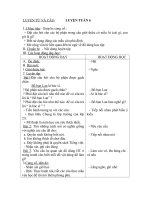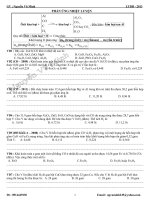LUYỆN từ VỰNG TIẾNG ANH how to use this book for maximum benefit
Bạn đang xem bản rút gọn của tài liệu. Xem và tải ngay bản đầy đủ của tài liệu tại đây (170.12 KB, 10 trang )
HOW TO USE THIS BOOK FOR MAXIMUM
BENEFIT
1. this is not a reading book…
Don’t read this book!
Instead, work with it. Talk aloud to it, talk back to it—use your voice,
not just your eyes and mind.
Learning, real learning, goes on only through active participation.
When a new word occurs in a chapter, say it aloud! (The phonetic
respelling will help you pronounce it correctly.)1
When you do the matching exercises, keep track of your responses.
(Check the key that immediately follows each exercise.)
When you do the “Yes-No,” “True-False,” or “Same-Opposite”
exercises, keep track of your responses, then check with the key when
you have completed the whole exercise.
When you are asked to ll in words that t de nitions, write your
answers on a piece of paper; then check the key both to see if you have
responded with the right word and also to make sure your spelling is
correct.
When you do the Review of Etymology exercises, make sure to ll in
the English word containing the pre x, root, or su x required—use a
chapter word, or any other word that comes to mind. (Coin words if
you like!)
Pay special attention to the Chapter Reviews. Are the words still fresh
in your mind? Do you remember the meaning of each root studied in
the previous sessions? In these Reviews, you are not only testing your
learning but also tightening up any areas in which you discover lacks,
weaknesses, or lapses of memory.
2. master the pronunciation system!
Saying words aloud, and saying them right, is half the battle in feeling
comfortable and assured with all the new words you are going to learn.
Every word taught is respelled to show its pronunciation, so pay close
attention to how the phonetic symbols work.
(a) First, master the “schwa”!
Almost every English word of two or more syllables contains one or
several syllables in which the vowel sound is said very quickly. For
example:
“Linda spoke to her mother about a di erent idea she had.”
→Read the previous sentence aloud at normal conversational speed.
Read it again. Listen to how the -a of Linda; the -er of mother; the a- of
about; the -er and -ent of di erent; and the -a of idea sound.
Very quick—very short! Right?
Phonetically respelled, these words are represented as:
1. Linda
LIN′-dƏ
2. mother
MU
3. about
Ə-BOWT′
4. di erent
DIF′-Ər-Ənt
5. idea
ī-DEE′-Ə
1. previous
PREE′-vee-Əs
2. sentence
SEN′-tƏns
3. aloud
Ə-LOWD′
4. normal
NAWR′-mƏl
5. conversational
kon′-vƏr-SAY′-shƏn-Əl
′-Ər
The symbol “Ə,” called a schwa, represents the quick, short vowel
sound in the ve words above.
Now look back at the sentence preceded by an arrow.
The italicized words are rewritten as:
You will nd Ə in almost all words that are phonetically respelled
throughout this book. Say the ve italicized words aloud and make sure
you understand how the schwa (Ə) sounds.
(b) Next, understand accent.
Look at word (5) above: conversational: kon′-vƏr-SAY′-shƏn-Əl. Note
that there are two accent marks, one on kon′, another on SAY′. Note
also that kon′ is in lower-case letters, SAY′ in capitals. Both syllables are
stressed, but the one in capitals (SAY′) sounds stronger (or louder) than
the one in lower case (kon′). Say conversational aloud, noting the
di erence.
Say these three words, taken from Chapter 3, aloud, noticing the
variation in stress between the lower-case and the capitalized syllables:
1. egomaniacal
ee′-gō-mƏ-NĪ′-Ə-kƏl
2. altercation
awl′-tƏr-KAY′-shƏn
3. anthropological
an′-thrƏ-pƏ-LOJ′-Ə-kƏl
(c) Be careful of the letter “S” (or “s”) in phonetic respellings. S (or s) is
always hissed, as in see, some, such. After an -n, you will be tempted to
buzz (or “voice”) the -s, because nal -ns is usually pronounced -nz, as
in wins, tons, owns, etc. (Say these three words aloud—hear the z at the
end?) Resist the temptation! S (or s) is always hissed in phonetic
respellings!
Say these words aloud:
1. ambivalence2
am-BIV′-Ə-lƏns
2. a uence
AF′-l -Əns
3. opulence
OP′-yƏ-lƏns
4. sentence
SEN′-tƏns
(d) The symbol ī or Ī is pronounced eye, to rhyme with high, sigh, my,
etc., no matter where you nd it. For example:
1. ghts
FĪTS
2. spy
SPĪ
3. malign
mƏ-LĪN′
4. civilize
SIV′-Ə-līz′
[I or i (without the top bar) is pronounced as in it, sit, pitch.]
(e) All consonants have their normal sounds.
Except for G (or g), which is always pronounced as in give, girl, get, go.
1. agree
Ə-GREE′
2. pagan
PAY′-gƏn
3. again
Ə-GEN′
(f) The vowel sounds are as follows:
SYMBOL
EXAMPLE
1. A, a
cat (KAT)
2. E, e
wet (WET)
3. I, i
sit (SIT)
4. O, o
knot (NOT)
5. U, u
nut (NUT)
6. AH, ah
martinet (mahr′-tƏ-NET′)
7. AW, aw
for (FAWR); incorrigible (in-KAWR′-Ə-jƏ-bƏl)
8. AY, ay
ate (AYT); magnate (MAG′-nayt)
9. EE, ee
equal (EE′-kwƏl); clandestinely (klan-DES′-tƏn-le
10. Ō, ō
toe (TŌ); concerto (kƏn-CHUR′-tō)
11.
,
book (B
K); prurient (PR
12.
,
doom (D
M); blue (BL
13. OW, ow
about (Ə-BOWT′)
14. OY, oy
soil (SOYL)
)
R′-ee-Ənt)
15. ING, ing
taking (TAYK′-ing)
(g) TH or th is pronounced as in thing;
this.
or
is pronounced as in
3. a word (or words) on western and eastern pronunciation
In the New York City area, and in parts of New Jersey and other
eastern states, the syllables -ar, -er, -or, -o , and -aw are pronounced
somewhat di erently from the way they are said in the Midwest and in
the West.
In New York City, for example, the words below are generally
pronounced as follows:
orange
AHR′-Ənj
talk
TAWK
co ee
KAW′-fee
sorority
sƏ-RAHR′-Ə-tee
incorrigible
in-KAHR′-Ə-jƏ-bƏl
disparage
dis-PAR′-Əj (A as in HAT)
merry
MER′-ee (E as in WET)
marry
MAR′-ee (A as in HAT)
astronaut
AS′-trƏ-nawt′
Harry
HAR′-ee (A as in HAT)
In the Midwest and West, on the other hand, the same words are
usually said approximately as follows:
orange
AWR′-Ənj
talk
TOK
co ee
KOF′-ee
sorority
sƏ-RAWR′-Ə-tee
incorrigible
in-KAWR′-Ə-jƏ-bƏl
disparage
dis-PAIR′-Əj
merry
MAIR′-ee
marry
MAIR′-ee
astronaut
AS′-trƏ-not′
Harry
HAIR′-ee
Nothing so radical here that a person brought up in Brooklyn or the
Bronx cannot understand a native of Los Angeles or San Francisco—it’s
just that each one thinks the other has an accent!
In California, for example, Mary, merry, and marry sound almost
exactly alike—in New York, they are usually heard as quite di erent
words.
(So, to be sexist for a moment, if the men at a party in Manhattan say,
“Let’s all make merry!”, Mary doesn’t feel that she is about to be
seduced by the males!)
In the phonetic respellings throughout the book, the western
pronunciations of words with the syllables remarked on above are used.
This is done largely because I myself have lived in the Los Angeles area
for some fourteen years, and have had to retrain my pronunciation
(having come from New York City, where I was born, and lived all my
life until 1964) so that my friends and students would stop making fun
of the way I speak.
Neither form of pronunciation is any better nor any more euphonious than
the other. Throughout the country, pronunciation varies not only from
region to region or state to state, but often from city to city! The
changes are slight and subtle, but they do exist, and an expert can easily
pinpoint the geographical source of a person’s language patterns almost
down to a few square miles in area.
If you are an Easterner, you will have no di culty translating the
pronunciations of words like sorority, incorrigible, disparage, and
astronaut (all words discussed in later chapters) into your own
comfortable language patterns.
4. why etymology?
Etymology (et′-Ə-MOL′-Ə-jee) deals with the origin or derivation of
words.
When you know the meaning of a root (for example, Latin ego, I or
self), you can better understand, and more easily remember, all the
words built on this root.
Learn one root and you have the key that will unlock the meanings of up
to ten or twenty words in which the root appears.
Learn ego and you can immediately get a handle on egocentric,
egomaniac, egoist, egotist, and alter ego.
Learn anthropos (Greek, mankind), and you will quickly understand,
and never forget, anthropology, misanthropy, anthropoid, anthropocentric,
anthropomorphic, philanthropy, and anthropophobia. Meet any word with
anthropo- in it, and you will have at least some idea of its meaning.
In the etymological (et′Ə-mƏ-LOJ′-Ə-kƏl) approach to vocabulary
building:
You will learn about pre xes, roots, and su xes—
You will be able to gure out unfamiliar words by recognizing their
structure, the building blocks from which they are constructed—
You will be able to construct words correctly by learning to put these
building blocks together in the proper way—and
You will be able to derive verbs from nouns, nouns and verbs from
adjectives, adjectives from nouns, etc.—and do all this correctly.
Learn how to deal with etymology and you will feel comfortable with
words—you will use new words with self-assurance—you will be able to
gure out thousands of words you hear or read even if you have never heard
or seen these words before.
That’s why the best approach to new words is through etymology3—
as you will discover for yourself as soon as you start to work on chapter
3!
5. but what are nouns, verbs, and adjectives?
You probably know.
But if you don’t, you can master these parts of speech (and reference
will be made to noun forms, verb forms, and adjective forms throughout
the book) within the next ve minutes.
(a) A noun is a word that can be preceded by a, an, the, some, such, or
my.
An egoist (noun)
Such asceticism (noun)
The misogynist (noun)
(Nouns, you will discover, often end in conventional su xes: -ness, ity, -ism, -y, -ion, etc.)
(b) A verb is a word that ts into the pattern, “Let us ___.” A verb has a
past tense.
Let us equivocate (verb)—past tense: equivocated.
Let us alternate (verb)—past tense: alternated.
Let us philander (verb)—past tense: philandered.
(Verbs, you will discover, often end in conventional su xes: -ate, -ize,
-fy, etc.)
(c) An adjective is a word that ts into the pattern, “You are very___.”
You are very egoistic (adjective).
You are very introverted (adjective).
You are very misogynous (adjective).
(Adjectives, you will discover, often end in conventional su xes: -ic, ed, -ous, -al, -ive, etc.)
And adverbs, of course, are generally formed by adding -ly to an
adjective: misogynous-misogynously; educational-educationally; etc.
That’s all there is to it! (Did it take more than
ten at the most?)
ve minutes? Maybe
6. how to work for best results
If you intend to work with this book seriously (that is, if your clear
intention is to add a thousand or more new words to your present
vocabulary—add them permanently, unforgettably—add them so
successfully that you will soon nd yourself using them in speech and
writing), I suggest that you give yourself every advantage by carefully
following the laws of learning:
(a) Space your learning.
Beginning with Chapter 3, every chapter will be divided into
“sessions.” Each session may take one half hour to an hour and a half,
depending on the amount of material and on your own speed of
learning.
Do one or two sessions at a time—three if you’re going strong and are
all involved—and always decide when you stop exactly when you will
return. (I remind you to do this later in the book, since such a
procedure is of crucial importance.)
(b) Do not rush—go at your own comfortable speed.
Everyone learns at a di erent pace. Fast learners are no better than
slow learners—it’s the end result that counts, not the time it takes you
to nish.
(c) Review.
When you start a new session, go back to the last exercise of the
previous session (usually Can you recall the words? or Chapter Review),
cover your answers, and test your retention—do you have quick recall
after a day or so has elapsed?
(d) Test yourself.
You are not aiming for a grade, or putting your worth on the line,
when you take the three Comprehensive Tests (Chapters 8, 13, and 17)
—rather you are discovering your weaknesses, if any; deciding where
repairs have to be made; and, especially, experiencing a feeling of
success at work well done. (In learning, too, nothing succeeds like
success!)
Use these three tests, as well as the abundant drill exercises, as aids to
learning. No one is perfect, no one learns in the exact same way or at
the same rate as anyone else. Find the optimum technique and speed for
your unique learning patterns—and then give yourself every
opportunity to exploit your actual, latent, and potential abilities.
But most important (as I will remind you several times throughout the
book)—develop a routine and stick to it!
1
The system of pronunciation symbols will be thoroughly explained in Section 2 of this chapter.
2
All unusual words in this chapter are taught in later chapters of the book.
3
Incidentally, Latin scholars will notice that I present a Latin verb in the rst person singular,
present tense (verto, I turn), but call it an in nitive (verto, to turn). I do this for two reasons: 1)
verto is easier for a non-Latin scholar to pronounce (the actual in nitive, vertere, is pronounced
WAIR′-tƏ-ray); and 2) when I studied Latin fty years ago, the convention was to refer to a verb
by using the rst person singular, present tense.
If you are not a Latin scholar, you need not bother to read this footnote—if you’ve already
done so, forget it!






